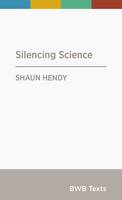Available now in bookshops nationwide.
 In 2009, seismologist Yukinobu Okamura warned Japan’s Nuclear and Industrial Science Agency that ‘a wall of water of the size that hit Fukushima Daiichi was quite possible during the lifetime of the plant’. This message never reached the public; the government dismissed it. The muzzling of science, in this instance, contributed to the world’s worst nuclear disaster after Chernobyl.
In 2009, seismologist Yukinobu Okamura warned Japan’s Nuclear and Industrial Science Agency that ‘a wall of water of the size that hit Fukushima Daiichi was quite possible during the lifetime of the plant’. This message never reached the public; the government dismissed it. The muzzling of science, in this instance, contributed to the world’s worst nuclear disaster after Chernobyl.
Shaun Hendy’s engaging book Silencing Science, which is part of the fantastic BWB Texts series (short books on big subjects), opens with the potentially devastating consequences that misinformation or the malfunctioning of science communication can have. This instantly gives rise to the question: could this happen here? From the start we are warned not to become complacent because Professor Hendy, director of Te Punaha Matatini (a New Zealand centre for research excellence), underlines that there are ‘rifts between our scientists, our politicians, and the public that put members of society at risk’.
Effective communication of science obviously has great use for us as a society and is also vital to an informed public, which in turn is part of a functioning democracy and any notion of consent being attributed to decisions made by those governing. Hendy bolsters these seemingly self-evident concepts throughout the book by illuminating why we need to be aware and vigilant of how this communication is under threat in Aotearoa. Indeed we soon see that science in the public sphere is undermined in myriad ways.
The frictions and complexities of science’s relationship with society, the media and policy-makers include: conflicts of interests; transparency issues; the insufficient independence of current scientific advisors; and the domino effect where scientists are cautious about speaking to journalists, journalists then don’t have access to good science or know how to engage with it, all of which results in a diminished public sphere. There is a reciprocal lack of trust between scientists and the public; some scientists are afraid of speaking out when funding is contingent upon certain sets of data or when there is the foreshadowing of attack on the horizon.
New Zealand is small and the country’s contact surface area is great, so the implications for misinformation or character assassinations are writ large when you can reach so much of society. There is also, as Hendy points out, very little doubling-up of expertise in the scientific world. This places a lot of responsibility on that sole expert’s shoulders, who might not come forward to speak at all if there is the threat of personal attack. Through these two factors of reach and singleness, our size has particular impact on public scientific discourse.
Hendy gives the example of Doug Sellman, who researches the harmful impacts of alcohol. With a few quick strokes of the keyboard, he was painted as a mad puritan on the infamous Whale Oil blog. As Hendy notes, other scientists, not ready to face attack, hang back and this diminishes the public sphere twice over as it ‘makes it easier to paint the likes of . . . Sellman as lone voices, driven by ideology and opportunity . . . rather than spokespeople for the scientific community’.
Without robust discussion, the culture of debate and critique is reduced and false balance enters public discourse. The most nefarious, commonly occurring example of this – due to the agency involved – is when interest groups and lobbyists manufacture public concern. Good ol’ fashioned fear mongering.
An example: Sir Peter Gluckman, Chief Science Advisor to the Prime Minister, recommended fortifying bread with folic acid, as a means of addressing serious birth defects. A campaign against such a move led to the National government rejecting the recommendation. This campaign exploited ‘a common misunderstanding of the way science works. Science is never certain, particularly so when investigating the very small risks of a range of possible harms’. Here those representing the food lobby groups (who were against the change) could pick and choose individual studies (and disregard wide range of studies and expert opinions that have formed some sort of consensus) that suited, thereby bolstering their interests and sewing doubt in the public, ‘even when the weight of evidence is against them’.
The variations in science’s pace in the book – from the sudden threat of an emergency such as the nuclear meltdown at Fukushima through to the subtler, slower builds of climate change, water quality and so on – take the reader through the vast network of elements that help or hinder science’s capacity to fulfil its function in the public interest. As Hendy says: scientific discovery ‘depends not on the brilliance of the individual’ but rather ‘on communication’. The dire consequences of muted scientific sphere are revealed and we are called on to both value the role of scientists as the ‘critic and conscience’ of society and safeguard it.
Reviewed by Emma Johnson
Silencing Science
by Shaun Hendy
Published by BWB Texts
ISBN 9780947492847
